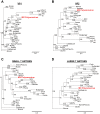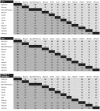Discovery of a novel polyomavirus in acute diarrheal samples from children
- PMID: 23166671
- PMCID: PMC3498111
- DOI: 10.1371/journal.pone.0049449
Discovery of a novel polyomavirus in acute diarrheal samples from children
Abstract
Polyomaviruses are small circular DNA viruses associated with chronic infections and tumors in both human and animal hosts. Using an unbiased deep sequencing approach, we identified a novel, highly divergent polyomavirus, provisionally named MX polyomavirus (MXPyV), in stool samples from children. The ∼5.0 kB viral genome exhibits little overall homology (<46% amino acid identity) to known polyomaviruses, and, due to phylogenetic variation among its individual proteins, cannot be placed in any existing taxonomic group. PCR-based screening detected MXPyV in 28 of 834 (3.4%) fecal samples collected from California, Mexico, and Chile, and 1 of 136 (0.74%) of respiratory samples from Mexico, but not in blood or urine samples from immunocompromised patients. By quantitative PCR, the measured titers of MXPyV in human stool at 10% (weight/volume) were as high as 15,075 copies. No association was found between the presence of MXPyV and diarrhea, although girls were more likely to shed MXPyV in the stool than boys (p=0.012). In one child, viral shedding was observed in two stools obtained 91 days apart, raising the possibility of chronic infection by MXPyV. A multiple sequence alignment revealed that MXPyV is a closely related variant of the recently reported MWPyV and HPyV10 polyomaviruses. Further studies will be important to determine the association, if any, of MXPyV with disease in humans.
Conflict of interest statement
Figures




Similar articles
-
[New, newer, newest human polyomaviruses: how far?].Mikrobiyol Bul. 2013 Apr;47(2):362-81. doi: 10.5578/mb.5377. Mikrobiyol Bul. 2013. PMID: 23621738 Review. Turkish.
-
Human polyomaviruses 10 and 11 in faecal samples from Brazilian children.Braz J Microbiol. 2020 Jun;51(2):585-591. doi: 10.1007/s42770-019-00166-3. Epub 2019 Oct 30. Braz J Microbiol. 2020. PMID: 31667802 Free PMC article.
-
Detection of novel polyomaviruses, TSPyV, HPyV6, HPyV7, HPyV9 and MWPyV in feces, urine, blood, respiratory swabs and cerebrospinal fluid.PLoS One. 2013 May 8;8(5):e62764. doi: 10.1371/journal.pone.0062764. Print 2013. PLoS One. 2013. PMID: 23667518 Free PMC article.
-
The prevalence of STL polyomavirus in stool samples from Chinese children.J Clin Virol. 2015 May;66:19-23. doi: 10.1016/j.jcv.2015.02.017. Epub 2015 Feb 26. J Clin Virol. 2015. PMID: 25866330
-
Genome analysis of the new human polyomaviruses.Rev Med Virol. 2012 Nov;22(6):354-77. doi: 10.1002/rmv.1711. Epub 2012 Mar 28. Rev Med Virol. 2012. PMID: 22461085 Review.
Cited by
-
New strategy for virus discovery: viruses identified in human feces in the last decade.Sci China Life Sci. 2013 Aug;56(8):688-96. doi: 10.1007/s11427-013-4516-y. Epub 2013 Aug 7. Sci China Life Sci. 2013. PMID: 23917840 Free PMC article. Review.
-
Seroepidemiology of Human Polyomaviruses in a US Population.Am J Epidemiol. 2016 Jan 1;183(1):61-9. doi: 10.1093/aje/kwv155. Epub 2015 Dec 13. Am J Epidemiol. 2016. PMID: 26667254 Free PMC article.
-
Human Polyomaviruses in the Cerebrospinal Fluid of Neurological Patients.Microorganisms. 2019 Dec 20;8(1):16. doi: 10.3390/microorganisms8010016. Microorganisms. 2019. PMID: 31861837 Free PMC article.
-
Copy Number Heterogeneity of JC Virus Standards.J Clin Microbiol. 2017 Mar;55(3):824-831. doi: 10.1128/JCM.02337-16. Epub 2016 Dec 14. J Clin Microbiol. 2017. PMID: 27974546 Free PMC article.
-
Genetic and Epidemiologic Trends of Norovirus Outbreaks in the United States from 2013 to 2016 Demonstrated Emergence of Novel GII.4 Recombinant Viruses.J Clin Microbiol. 2017 Jul;55(7):2208-2221. doi: 10.1128/JCM.00455-17. Epub 2017 May 10. J Clin Microbiol. 2017. PMID: 28490488 Free PMC article.
References
-
- Braun WE (2003) BK polyomavirus: a newly recognized threat to transplanted kidneys. Cleve Clin J Med 70: 1056, 1059–1060, 1062 passim. - PubMed
-
- Hou J, Major EO (2000) Progressive multifocal leukoencephalopathy: JC virus induced demyelination in the immune compromised host. J Neurovirol 6 Suppl 2: S98–S100. - PubMed
Publication types
MeSH terms
Grants and funding
LinkOut - more resources
Full Text Sources
Other Literature Sources
Medical
Molecular Biology Databases

